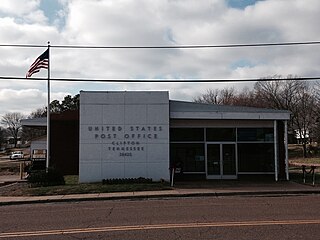
Sevierville is a city in and the county seat of Sevier County, Tennessee, located in eastern Tennessee. The population was 17,889 at the 2020 United States Census.

Clifton is a city in Wayne County, Tennessee, on the state's south central border with Alabama. It developed as a river port along the Tennessee River in the 19th century. Its historic districts listed on the National Register of Historic Places are associated with this period. The population was 2,694 at the 2010 census.

Thomas Sigismund Stribling was notable as an American writer who published under the name T. S. Stribling. Although he passed the bar and practiced law for a few years, he quickly began to focus on writing. First known for adventure stories published in pulp fiction magazines, he enlarged his reach with novels of social satire set in Middle Tennessee and other parts of the South. His best-known work is the Vaiden trilogy, set in Florence, Alabama. The first volume is The Forge (1931). He won the Pulitzer Prize for the Novel in 1933 for the second novel of this series, The Store. The last, set in the 1920s, is The Unfinished Cathedral (1934). Both the second and third novels were chosen as selections by the Literary Guild.

Golden Hill is an affluent and historic neighborhood overlooking the White River on the west side of Indianapolis's Center Township, in Marion County, Indiana. The district is bounded on the east by Clifton Street, which is west of Martin Luther King Jr. Boulevard ; on the west by the White River and the Central Canal; on the south by Thirty-sixth Street; and on the north by Woodstock Country Club, immediately south of Thirty-eighth Street. Golden Hill is noted for its collection of homes designed by several of the city's prominent architects. The estate homes reflect several styles of period revival architecture. The district is known as for its community planning and remains an exclusive enclave for the city's prominent families. Golden Hill was added to the National Register of Historic Places in 1991.

The John B. Tytus House is a historic house at 300 South Main Street in Middletown, Ohio, United States. Built in 1865,it was the home of John Butler Tytus (1875-1944), who invented a practical hot wide-strip continuous steel-rolling process that transformed the American steelmaking industry. The house was designated a National Historic Landmark in 1976 due to the efforts of Jeri and Pat Rossi, who bought the house in 1970. The house was the residence of the Rossi family until 2011. >James Sheire, National Register of Historic Places Inventory-Nomination: John B. Tytus House(pdf), National Park Service and Accompanying 3 photos, exterior, from 1974 (32 KB)</ref>

The South Glastonbury Historic District is a historic district in Glastonbury, Connecticut. It encompasses the historic village center of South Glastonbury, which was first settled in the 17th century. The district was listed on the National Register of Historic Places in 1984, and enlarged in 2009 to include properties further along Main Street as far as Chestnut Hill Road. Locals refer to it as Nayaug.

The Bean Hill Historic District is a historic district in Norwich, Connecticut that was listed on the National Register of Historic Places in 1982. It consists of a well-preserved collection of buildings focused on the Bean Hill Green, which capture the 19th-century period when Bean Hill was a local center for manufacturing and commercial activity. The district is located in the vicinity of West Town Street between I-395 and Connecticut Avenue, and also extends northeast along Huntington Avenue to include properties further beyond Bean Hill Plain. The district is about 22 acres (8.9 ha) in size, with 23 contributing buildings.

The Riverview Terrace Historic District is a 15.2-acre (6.2 ha) historic district in Davenport, Iowa, United States, that was listed on the National Register of Historic Places in 1984. It was listed on the Davenport Register of Historic Properties in 1993. The neighborhood was originally named Burrow's Bluff and Lookout Park and contains a three-acre park on a large hill.

Lindbergh Forest is a neighborhood in Knoxville, Tennessee, United States, located off Chapman Highway (US-441) in South Knoxville, that is listed on the National Register of Historic Places as an historic district. Initially developed in the late 1920s as one of Knoxville's first automobile suburbs, the neighborhood is now noted for its late-1920s and early-1930s residential architecture, and the use of East Tennessee marble detailing. The neighborhood also contains two of Knoxville's five surviving Lustron houses. In 1998, several of its houses were added to the National Register of Historic Places as the Lindbergh Forest Historic District.
Baltimore Heritage is an American nonprofit historic-preservation organization headquartered in Baltimore, Maryland.

Ferry & Clas was an architectural firm in Wisconsin. It designed many buildings that are listed on the National Register of Historic Places. George Bowman Ferry and Alfred Charles Clas were partners.

Pierce & Bickford was an American architectural firm active in Elmira, New York from 1891 to 1932. It was formed as the partnership of architects of Joseph H. Pierce (1855-1932) and Hiram H. Bickford (1864-1929), with later partner Robert T. Bickford (1894-1988).
The Walter Cliff Ranch District, at 7635 Old HW 395 in Washoe Valley, Nevada is a historic site that was listed as a historic district on the National Register of Historic Places in 1985. It has significance dating from c.1870, when the house was built. The listing included two contributing buildings: the house and a root cellar/residence building.

The Wiscasset Historic District is a 101-acre (41 ha) historic district that encompasses substantially all of the central village of Wiscasset, Maine. The district includes at least 22 contributing buildings and two other contributing sites, one being a cemetery whose oldest stone is from 1739. Located on the west bank of the Sheepscot River and settled in the 18th century, Wiscasset was a prominent harbor in Mid Coast Maine, and a major shipbuilding and merchant port, until the War of 1812 ended its prosperity. The village center includes fine examples of Federal period architecture, most built between about 1780 and 1820, including one National Historic Landmark, the Nickels-Sortwell House. The district was listed on the National Register of Historic Places in 1973.
The LeClair Avenue Historic District encompasses a small residential development on LeClair Avenue and North Street in Winooski, Vermont. Subdivided and developed by Francis LeClair, a prominent local businessman, the well-preserved working-class residences typify development of the period catering to the area's growing French-Canadian immigrant community. The district was listed on the National Register of Historic Places in 1992.

The Pucker Street Historic District is a nationally recognized historic district located in Marion, Iowa, United States. It was listed on the National Register of Historic Places in 2002. At the time of its nomination it consisted of 84 resources, which included 50 contributing buildings, three contributing structures, two contributing objects, and 29 non-contributing buildings. The historic district is a residential area near Marion's central business district. The people who initially built homes here were the city's pioneer families and then their descendants. It is also where the city's wealthy and influential citizens built their houses along Eighth Avenue and its adjacent streets. The neighborhood was called "Pucker Street" because of the superior attitudes that some of its early residents were said to have possessed.

The Justice and Police Museum is a heritage-listed former water police station, offices and courthouse and now justice and police museum located at 4-8 Phillip Street on the corner of Albert Street, in the Sydney central business district in the City of Sydney local government area of New South Wales, Australia. It was designed by Edmund Blacket, Alexander Dawson and James Barnet and built from 1854 to 1886. It is also known as Police Station & Law Courts (former) and Traffic Court. The property is owned by the Department of Justice, a department of the Government of New South Wales. It was added to the New South Wales State Heritage Register on 2 April 1999.

The Old Mine Road Historic District is a 687-acre (278 ha) historic district located along Old Mine Road in Sussex County and Warren County, New Jersey. It is part of the Delaware Water Gap National Recreation Area. The district was added to the National Register of Historic Places on December 3, 1980, for its significance in agriculture, archaeology, architecture, commerce, exploration/settlement, and transportation. It includes 24 contributing buildings and five contributing sites.

The South Main Street Historic District in Memphis, Tennessee, is located south of the city's central business district encompassing over 100 mostly commercial buildings spread across 11 blocks. The area was constructed between 1900 and 1930 in a wide range of early-twentieth-century architectural styles including Beaux Arts, Georgian Revival, Art Deco and Chicago Commercial. The district was added to the National Register of Historic Places in 1982 as an area of Memphis representing the impact of the railroad on the city during the a period of railroad-led prosperity that ended with the Great Depression. The district includes the Lorraine Motel, constructed in 1925, where Martin Luther King Jr. was assassinated in 1968. The South Main Arts District is a smaller area within the historic district. The district is also a City of Memphis local historic district or Historic Overlay District.
















